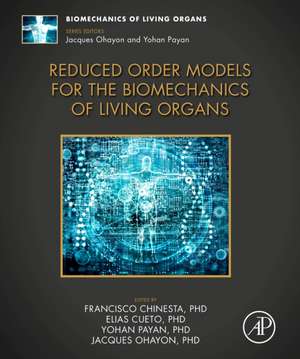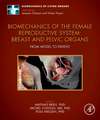Reduced Order Models for the Biomechanics of Living Organs: Biomechanics of Living Organs
Editat de Francisco Chinesta, Elias Cueto, Yohan Payan, Jacques Ohayonen Limba Engleză Hardback – 26 mai 2023
This book provides an opportunity for students, researchers, clinicians and engineers to study the main topics related to biomechanics and reduced models in a single reference, with this volume summarizing all biomechanical aspects of each living organ in one comprehensive reference.
- Introduces the fundamental aspects of reduced order models
- Presents the main computational studies in the field of solid and fluid biomechanical modeling of living organs
- Explores the use of reduced order models in the fields of biomechanical electrophysiology, tissue growth and prosthetic designs
Preț: 912.03 lei
Preț vechi: 1187.48 lei
-23% Nou
Puncte Express: 1368
Preț estimativ în valută:
174.51€ • 182.70$ • 144.40£
174.51€ • 182.70$ • 144.40£
Carte tipărită la comandă
Livrare economică 31 martie-14 aprilie
Livrare express 28 februarie-06 martie pentru 118.20 lei
Preluare comenzi: 021 569.72.76
Specificații
ISBN-13: 9780323899673
ISBN-10: 0323899676
Pagini: 492
Ilustrații: Approx. 250 illustrations (250 in full color)
Dimensiuni: 191 x 235 x 32 mm
Greutate: 1.17 kg
Editura: ELSEVIER SCIENCE
Seria Biomechanics of Living Organs
ISBN-10: 0323899676
Pagini: 492
Ilustrații: Approx. 250 illustrations (250 in full color)
Dimensiuni: 191 x 235 x 32 mm
Greutate: 1.17 kg
Editura: ELSEVIER SCIENCE
Seria Biomechanics of Living Organs
Cuprins
Part 1: Backgrounds and Fundamentals of Reduced Order Models
1. An introduction to Model Order Reduction Techniques
2. Linear and nonlinear dimensionality reduction of biomechanical models
3. Shape parameterizations for reduced order modeling in biophysics
4. Data-driven modelling and artificial intelligence
5. Deep Learning for Real-Time Computational Biomechanics
6. An introduction to Pod-Greedy-Galerkin reduced basis method
7. Machine learning and biophysical models: how to benefit each other?
Part 2: Applications to Computational Fluid Biomechanics
8. Fast and accurate numerical simulations for the study of coronary artery bypass grafts by artificial neural network
9. Reduced Order Models for Fluid inside Aneurysms using Proper Orthogonal Decomposition
10. Isogeometric Hierarchical Model Reduction for advection-diffusion process simulation in microchannels
11. Fast closed-loop CFD model for patient-specific aortic dissection management
12. Reduced order modelling for direct and inverse problems in haemodynamics
Part 3: Applications to Computational Solid Biomechanics and living tissues
13. Model Order Reduction of a 3D biome-chanical tongue model: a necessary step for quantitative evaluation of models of speech motor control and planning
14. Deep learning contributions for reducing the complexity of prostate biomechanical models
15. Reduced Mechanical model of trunk-lumbar belt interaction for design-oriented in-silico clinical trials
16. ROM-based patient-specific structural analysis of vertebrae affected by metastasis
17. Reduced Order Models for Prediction of Successful Course of Vaginal Delivery
18. Modeling and simulation of a realistic knee joint using biphasic materials by the means of the proper generalized decomposition
19. Comparison of three machine learning methods to estimate myocardial stiffness
Part 4: Applications to Biomechanical Electrophysiology, Image processing and Surgical protocols
20. Real-time numerical prediction of strain localization using dictionary-based ROM-nets for sitting-acquired deep tissue injury prevention
21. Reduced order modeling of the cardiac function across the scales
22. Surgery simulators based on model order reduction
1. An introduction to Model Order Reduction Techniques
2. Linear and nonlinear dimensionality reduction of biomechanical models
3. Shape parameterizations for reduced order modeling in biophysics
4. Data-driven modelling and artificial intelligence
5. Deep Learning for Real-Time Computational Biomechanics
6. An introduction to Pod-Greedy-Galerkin reduced basis method
7. Machine learning and biophysical models: how to benefit each other?
Part 2: Applications to Computational Fluid Biomechanics
8. Fast and accurate numerical simulations for the study of coronary artery bypass grafts by artificial neural network
9. Reduced Order Models for Fluid inside Aneurysms using Proper Orthogonal Decomposition
10. Isogeometric Hierarchical Model Reduction for advection-diffusion process simulation in microchannels
11. Fast closed-loop CFD model for patient-specific aortic dissection management
12. Reduced order modelling for direct and inverse problems in haemodynamics
Part 3: Applications to Computational Solid Biomechanics and living tissues
13. Model Order Reduction of a 3D biome-chanical tongue model: a necessary step for quantitative evaluation of models of speech motor control and planning
14. Deep learning contributions for reducing the complexity of prostate biomechanical models
15. Reduced Mechanical model of trunk-lumbar belt interaction for design-oriented in-silico clinical trials
16. ROM-based patient-specific structural analysis of vertebrae affected by metastasis
17. Reduced Order Models for Prediction of Successful Course of Vaginal Delivery
18. Modeling and simulation of a realistic knee joint using biphasic materials by the means of the proper generalized decomposition
19. Comparison of three machine learning methods to estimate myocardial stiffness
Part 4: Applications to Biomechanical Electrophysiology, Image processing and Surgical protocols
20. Real-time numerical prediction of strain localization using dictionary-based ROM-nets for sitting-acquired deep tissue injury prevention
21. Reduced order modeling of the cardiac function across the scales
22. Surgery simulators based on model order reduction



